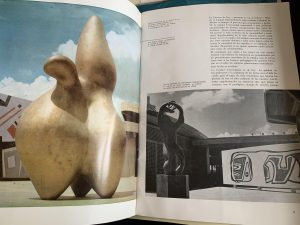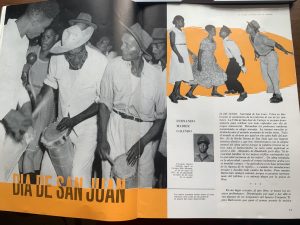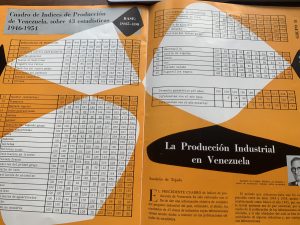Guest post by Evelyn MacPherson, GSAS student

At the start of my internship with the Rare Books and Manuscript Library I was asked if I knew what my dissertation would be on— a fair question for any rising fourth year PhD candidate, albeit a daunting one. I’d been asking myself the same question, and I said something vague about the relationship between political fictions and the magical thinking associated with oil extraction. At the time, I was finishing up processing my first collection– the papers for the Center for Economic and Social Rights– and was searching for a new collection. There had been some discussion about possibly processing the papers of the Puerto Rican surrealist photographer Adál Maldonado. From the limited amount I knew about Maldonado, the collection sounded intriguing, if not immediately applicable to my research interests. In mid-June I received an email from Kevin Schlottmann, Head of Archives Processing, with the subject heading “Slater papers.” His opening sentence began like the hook to a thriller: “I have no idea if this is a doable project, but…” Based on my vague response about my impending dissertation Kevin had generously searched for unprocessed collections with the word “oil” in their descriptions. The result: the papers of a man who, according to the description on CLIO, was involved in the reconstruction of Germany, had been a member of the policy planning staff at the State Department that helped plan the United Nations, served under Eisenhower and Kennedy, and who had, yes, “held various positions as an economist, including Head of the General Economics Section of the Creole Petroleum Corporation and chief economist for Standard Oil Company” (CLIO). I replied to Kevin’s email that I was happy to work on this collection and so began an unexpected adventure in the archive.
I can’t tell you definitively what I thought I would find in the Slater papers. I was worried I would find myself waist deep in oil data, or reading the maniacal letters of oil barons. In the early stages of surveying the collection it was hard to tell what exactly I was looking at, what man these papers seemed to recreate, but they certainly didn’t align with that reality. After all, the very first item I saw was a copy of The Bennington Review, a literary anthology produced by the son of Shirley Jackson. Throughout the surveying process Joseph Slater remained hard to pin down, in part because he had been involved in so many major historical moments, institutions and corporations. He had moved from the Allied High Commission to Creole Petroleum, from there to the Ford Foundation, taken two sabbaticals where he worked under American Presidents, and had ultimately spent over a decade transforming the Aspen Institute into a world-recognized think tank. He had lived in the same building as Walter Cronkite, Truman Capote, and Johnny Carson. His correspondence included invitations from Jackie Kennedy, notes from Henry Kissinger and, in the later years of his life, letters from renowned artists who he was recommending (unsolicited I may add), for MacArthur genius grants. There is a lot I could say about this collection, each detail intriguing to a different individual depending on whether they are interested in World War Two, corporate America, or decades worth of foreign affairs documentation. I don’t have space for all of that, so instead I will tell you what piqued my interest and how working on this collection has influenced my dissertation and fundamentally changed how I view myself as a researcher.
When I received the Slater papers they had been partially processed several years before. One series in particular had been refoldered and rehoused, it was there that I began with this round of processing– fortuitously, this series coincided with Slater’s time with Creole Petroleum. I had learned from CLIO and Wikipedia alike that Slater had served as the Chief Economist for Creole Petroleum, the Venezuelan subsidiary of Standard Oil, New Jersey. Armed with this information I anticipated some of what I saw in these boxes: reports on oil extraction in various Latin American countries, economic reviews of Venezuela and annual reports for the corporation. What I had not expected was the work completed by Fundación Creole, the culture and education arm of Creole Petroleum that Joseph Slater founded in 1956 to transform the company into a “good corporate citizen.”
Slater detailed his first impressions of the company in a December 12, 1955 letter; in it Slater outlines his preliminary idea for the Creole Foundation, as well as why the company needs to enhance its public image. “Creole faces the same problem in a sense as that faced by the U.S. Embassy. Namely, how can the identification of interests be made with a broad sector of the nation without being accused of intervention or interference to domestic affairs?” He details his solution in the next sentence: “it is primarily under this motivation that I have been proposing the study of the possibilities of a radio and T.V. public service program designed for Venezuelan schools” (Box 7, folder 1). His solution is, perhaps, counter-intuitive. In order to not appear too interested in domestic affairs, Venezuela was in the midst of a military dictatorship which interrupted a broader 20th century trend of relative democracy in the country, the corporation would place itself at the root of the nation: in schools. Slater describes this strategy through the logic of good will, but he also concedes that this programming is first and foremost a matter of public image for the corporation. On November 30th, 1955 he further explains the objectives of the program, one of which is “to provide an identification by Venezuelan youth (which would be carried on to adulthood) of Creole as a benefactor to the community and as a company which is sincerely concerned with the broad interests of the Venezuelan nation” (Box 7, folder 1). Indeed, the TV and radio program is just the start of a campaign meant to reach well into the future, and the program was just beginning of a large scale effort to maintain Creole Petroleum’s image as it capitalized on resources both environmental and human.
Throughout the 1960s the foundation grew and expanded its role in the education sector and as a patron of the arts. A pamphlet from its first year (1956), stated that “the Creole Foundation’s programs particularly stress the support of individual study at all levels of the educational system. In fact, well over half of the first year’s budget, which exceeds $1,000,000 is devoted to scholarships, fellowships, additional training of experts, international exchange of professors and individuals engaged in research, vocational training, short summer school courses, and similar activities” (box 7, folder 2). All of this is true, and the foundation continued these programs and awards throughout the 1960s. Some supplied secondary schools with books, while others took the form of scholarships to the US for Venezuelan painters and collateral grants with US universities. A November 18, 1956 New York Times article lauded Creole Petroleum as “a corporate good citizen,” writing “the Standard Oil Company of New Jersey has once again given striking evidence of corporate good citizenship. Its financial support of higher education in this country is well known… through its subsidy the Creole Petroleum Corporation it has now organized the Creole Foundation in Venezuela– said to be the first organization of this kind to be set up by an American concern abroad… it will carry forward into new ground an interest which the leading “foreign” oil companies have long taken in Venezuelan cultural life” (box 7, folder 15). The article is a rave, and although it is easy now to question the validity of the concept of a good corporate citizen and the potentially coercive elements of foreign control over domestic education, Fernando Coronil reminds us in his work on Venezuela that in an oil-nation the postcolonial state is a neo-colonial one.
Yet, by the time Joseph Slater founded Fundación Creole, Creole Petroleum had already established an extended history of cultural and intellectual production in Venezuela. For over two decades, Standard Oil had produced a number of magazines meant to relay oil information to its investors and other interested parties. In the United States, readers were treated to the glossy pages of The Lamp. A couple of copies of The Lamp are located within the Slater papers. They are filled with large color photographs of oil fields in, the magazine insists, far off lands. The Lamp often partakes in an exoticism and an orientalism hinted at in its title where a lamp is both an oil-fueled source of light and a vessel with magical potential. An article about the extraction process from the April, 1953 edition of The Lamp is titled “The Wonderful Wizards of Oil” and is accompanied by a drawing of refineries and the captioned “Fed by pipeline, tanker or both, the surrealistic ‘factory’ transforms incoming crude oil into fuels, lubricants and basic chemicals” (box 6, folder 1). Through The Lamp Standard Oil positions itself as the procurer of enlightenment and extraordinary resource extraction; the company is both philosopher and magician.

The Lamp’s Venezuelan sister publication, El Farol (literally, the lamp in Spanish), is even more fascinating as a source of cultural expression. Whereas the English language publication focused on the machinations of the oil industry, El Farol coupled this information with articles written by Venezuela’s premier intellectuals. Important writers such as Mariano Picón Salas, Arturo Uslar Pietri, Juan Pablo Sojo, Ramón Díaz and Miguel Acosta Saignes, and artists such as Armando Reverón and Héctor Poleo appear throughout editions of El Farol. The magazine functions as both an oil publication and a marker of Venezuelan nationalism and modernity, a complicated duality that I am still wrapping my head around.
Joseph E. Slater did not start El Farol, although he did refer to it often while he presided over Creole Petroleum’s public relations committee and he clearly saw it as another component of the company’s image as goodwill ambassadors. When I was initially surveying Slater’s papers, a typed letter from a friend caught my eye. Attached to the back was a New Yorker cartoon. In the cartoon, two Vikings chat as they pillage a nondescript village. One Viking jokes to the other that, “They really would like us more if we threw some money at the arts.” As the note from a friend suggests, the cartoon strikes a chord with Slater’s professional life. Throughout his career, he focused on public relations and international affairs programs for major corporations including Ford and Volvo, while questioning how those corporations could assist society through the reallocation of funds, with an emphasis on arts and culture. Even in that context though, his role in the creation of the Creole Foundation remains unique.

In many ways the Creole Foundation resonates more closely with President Kennedy’s Bureau of Educational and Cultural Affairs, a subset of the State Department that, according to the State Department website, was created “to increase mutual understanding between the people of the United States and the people of other countries by means of educational and cultural exchange that assist in the development of peaceful relations.” Slater was the first Deputy Assistant of State for Education and Cultural Affairs from 1961-62, and looking through his papers it is plain that his experience at Creole Petroleum influenced his time with the State Department. Slater was already aware of the similarities between Creole Petroleum’s exertion of power and that of the United States government. In his papers he compared Creole Petroleum to an American embassy, and in a preliminary plan for the Creole Foundation he noted that the corporation should hire a “top-level speech writer of the caliber now employed by ranking statesmen in the U.S. government” (Box 7, folder 1).
Creole Petroleum and the Bureau of Educational and Cultural Affairs both saw culture and education as arenas in which larger objectives could be advanced. As the cartoon alludes to, the misdeeds of neo-colonialism, corporate greed, and environmental degradation may be overlooked if cultural endeavors are funded and placed in the limelight. Here lies the cultural alibi. However, for both Creole Petroleum and the Bureau of Educational and Cultural Affairs, the realms of culture and education are more than an alibi — rather, these fields are used as tools for institutional gain. In the case of the Bureau of Educational and Cultural Affairs, these global cultural campaigns were part of a Cold War effort to fight Communism. For Creole Petroleum, their culture and education focused foundation ensured that oil culture permeated school libraries, book festivals, and the media.
I did not begin processing the 30 boxes of the Slater papers with any expectation that they would color my dissertation. And yet, I’ve left with so many provocative questions about the relationship between multinational corporations such as oil companies and cultural production: what role do these corporations play in the maintenance of canons? How are these works of corporate authorship related to neocolonial pursuits? And in turn, can we locate resistance within these objects? These are the questions now informing the early stages of my dissertation, and I know that I would not have begun asking them if it was not for these boxes, the RBML, and the primary source internship. Through this internship I’ve come to I better appreciate the labor involved in making archives accessible, and because I now have a better sense of how primary source documents fit together in the context of other papers, files and objects.